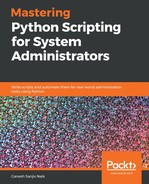The elif statement checks multiple statements for a true value. Whenever the value evaluates to true, that code block gets executed. Refer to the following syntax:
if test expression:
if block statements
elif test expression:
elif block statements
else:
else block statements
elif is short for else if. It allows us to check for multiple expressions. If the condition written in the if statement is false, then it will check the condition of the next elif block, and so on. If all of the conditions are false, the body of else is executed.
Only one block among the several if...elif...else blocks is executed according to the condition. The if block can have only one else block. But it can have multiple elif blocks. Let's take a look at an example:
a = 10
if a > 50:
print("a is greater than 50")
elif a == 10:
print("a is equal to 10")
else:
print("a is negative")
Output:
a is equal to 10
